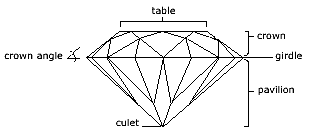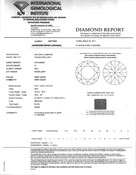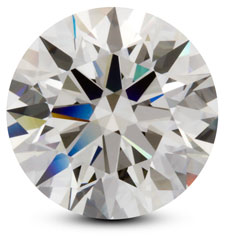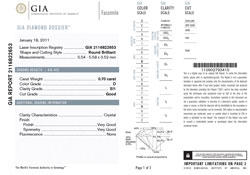Smoking gun!
Lots of sellers advertise "certified diamonds." But it makes a big difference who did the "certifying." What if two labs report on the same stone—and the descriptions don't match? Which report do you believe?
|
One diamond, two certs
In a fortuitous occurrence, we recently were able to examine two diamond reports written by two different labs for the same stone. Insurers rarely have the opportunity to make such a side-by-side comparison, but this example illustrates a widespread problem.
In this case, the earlier report (Jan. 18, 2011) was written by GIA (Gemological Institute of America), a highly respected grading lab. In fact, it is GIA that established the color and clarity grading standards that are internationally recognized and used.
Several weeks later (March 30, 2011) the same stone was graded by the IGI (International Gemological Institute). We know it was the same stone because both reports mention the GIA report number that was engraved on the stone's girdle by GIA. Apparently the client was dissatisfied with the GIA grades and hoped for a better report from IGI, a lab known in the industry for its favorable grading and appraisal reports.
 This is how two reports on the same stone differed:
This is how two reports on the same stone differed:
|
IGI | GIA |
| Clarity grade | VS2 | SI1 |
| Cut grade | Excellent | Good |
| Girdle thickness | Slightly thick to thick | Very thick |
| Culet | Medium | None |
What the grades mean
CLARITY GRADE
IGI's clarity grade is a step higher than GIA's. VS2 ("Very Slightly" included) means that inclusions are somewhat difficult to see under 10x magnification. SI1 ("Slightly Included") means inclusions are readily seen at 10x magnification.
CUT GRADE
IGI's grade is two steps higher than GIA's. Cut, referring to the proportions of the stone, determines the stone's geometry and play of light. A diamond's cut is a major determinant of its value. IGI judges the stone's cut as Excellent, while GIA finds it merely Good.
GIRDLE THICKNESS
 The girdle is where the setting holds the stone, and there is an optimal thickness for the girdle. IGI says this stone's girdle is Slightly Thick to Thick, while GIA describes it as Very Thick. An excessively thick girdle adds to the stone's carat weight—and therefore to its price—without improving the stone's appearance.
The girdle is where the setting holds the stone, and there is an optimal thickness for the girdle. IGI says this stone's girdle is Slightly Thick to Thick, while GIA describes it as Very Thick. An excessively thick girdle adds to the stone's carat weight—and therefore to its price—without improving the stone's appearance.
CULET
The culet is the bottom facet of the stone. IGI says this stone has a Medium culet, GIA says it has None. Lack of a culet facet makes the stone more vulnerable to damage there.
Recording cut geometry is not a matter of opinion but a precise science. In fact, sophisticated technology exists which can calculate a stone's exact proportions.
Bottom Line: Valuation
- Every attribute on the diamond report affects valuation.
- Inflated grading means an inflated valuation.
Based on the information given by the two labs, we consulted three sources. This is what we found:
Valuation for diamond as described by IGI: $4,158
Valuation for diamond as described by GIA: $3,080 – 26% lower!
Pervasive problem
Inflated lab reports are increasingly prevalent. Many sellers give a lab report with each sale, to confirm the seller's description of the gem. Often the report comes from IGI or other less than scrupulous labs that engage in "flexible grading" which exaggerates the qualities of the jewelry. A lab report with inflated grading may make the customer feel good but it is actually lying to the buyer. Such documents also make it impossible for the buyer to truly comparison shop.
In the case described above, the stone dealer was apparently unhappy with the GIA grades and chose to submit to the retailer, and ultimately to the insurer, only the IGI report with its inflated grades. But since the IGI cert mentions the GIA report number that had been inscribed on the stone, the insurer was able to locate the GIA diamond report online. The GIA report gives a truer description of the stone.
GIA is regarded as the final authority on diamond grading. Whenever there is a conflict of opinion about the qualities of a diamond, insurers should rely on the GIA grades.
Insurers who unknowingly use inflated gem reports as the basis for coverage are likely to both over-insure and overpay on a settlement.
FOR AGENTS & UNDERWRITERS
Ask clients to submit all appraisals and gem reports, as they may contain different information. If an appraisal or gem report references any other documents, those documents should also be in your files.
The IGI report in this article mentioned the GIA report number inscribed on the diamond's girdle. This report number allowed the insurer to go online for a copy of the GIA report.
If you have a lab report number but do not have the report itself, or if you have a report that you want to verify, you can often get a copy online. Here are the links for verifying reports from the major labs:
GIA
AGL
Gübelin
AGS
GCAL
IGI
EGL
FOR ADJUSTERS
Examine the documents for references to lab reports not in your files. Comparing data from all available reports and appraisals could help avoid overpaying a settlement.
GIA is the most highly regarded authority on diamond grading. Other labs may use more flexible grading. To avoid overpayment when replacing a diamond, match the stone to the report on file. For example:
If you are working with an IGI report, replace the stone with an IGI-certified diamond of the stated qualities.
If you are working with a GIA report, replace the stone with a GIA-certified diamond of the stated qualities.
You can verify reports from major gem-grading labs by following the links above.
©2000-2025, JCRS Inland Marine Solutions, Inc. All Rights Reserved. www.jcrs.com




